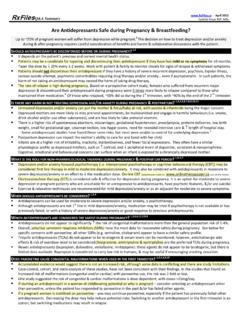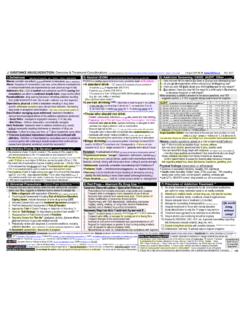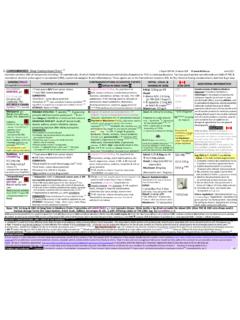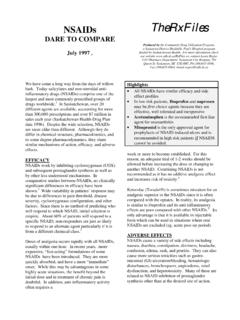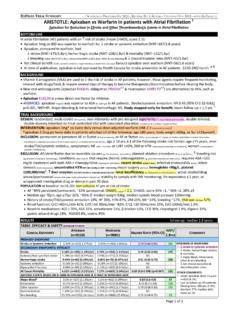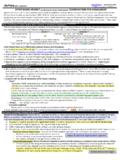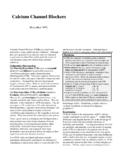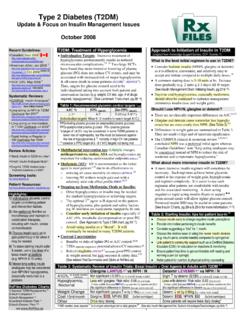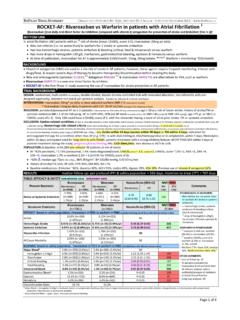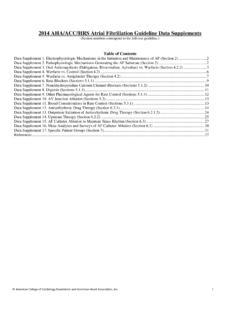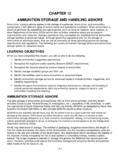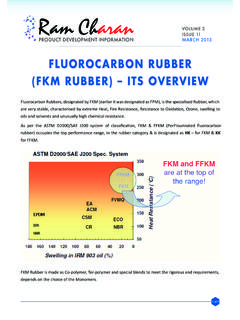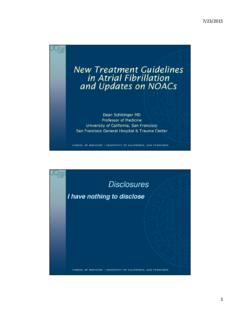Transcription of AF-Newsletter January 2013 - RxFiles
1 GUIDELINES/REVIEWS CCS 2010, 2012 update: afib guidelines CADTH 2012 : Oral ESC 2010, 2012 update: +html AHA/ASA 2012 : ACCF/AHA/HRS2006,2011 update: +html CHEST 2012: RISK CALCULATORS/TOOLS SPARC CCPN SPAF Framingham Heart Study PATIENT RESOURCES See On Line Extras for list & links. RxFiles RELATED Oral Anticoagulation in AF Antiplatelet & Antithrombotics Drug Chart Warfarin Tips/Nomograms also see last page of newsletter Does Dabigatran risk of MI QT Prolongation & Torsades QA% ACTIVE A & W (ASA clop, vs warf) A Trial ARISTOTLE (apixaban vs warfarin) AF RACE II (lenient vs strict rate control) II RE LY (dabigatran vs warfarin) LY Trial ROCKET AF (rivaroxaban vs warfarin) AF PALLAS (dronedarone in permanent AF) trial% Highlights Assess stroke CHADS2, CHA2DS2 VASc & bleeding HAS BLED risk.
2 If CHADS2 1, consider using CHA2DS2 VASc. If HAS BLED 3, oral anticoagulant use requires caution. New oral anticoagulants (NOACs) vs warfarin: Advantages: non inferior for stroke & systemic embolism, no INR monitoring, & fewer drug interactions. Disadvantages: no bleeding antidote, no long term data or real world experience >2 years, limited cardiovascular outcome data, & medication cost. No significant difference between rate control vs. rhythm control in mortality or stroke risk. Background Issues Individuals with atrial fibrillation (AF) have 3 to 5 fold increased risk for ischemic stroke. Key symptom is irregular pulse (may not be rapid). Approach to Managing AF Identify & treat precipitating causes, if possible.
3 Manage thromboembolic risk: Calculate stroke risk (CHADS2, CHA2DS2 VASc) Calculate bleed risk (HAS BLED) Manage arrhythmia (rate vs. rhythm control). CHADS2 versus CHA2DS2 VASc for estimating risk of stroke Both tools help guide antithrombotic therapy & have a similar ability to estimate the risk of stroke in AF. CHADS2 score is easier to remember & use. CHA2DS2 VASc is better for estimating stroke risk in low or intermediate risk individuals ( CHADS2 score 1). CHADS2 = 0: AF guidelines recommend considering gender (female), presence of vascular disease & age ( 65 years) to guide therapy ( CHA2DS2 VASc). HAS BLED for estimating the risk of major bleeding Compared to other bleeding risk prediction tools, HAS BLED is easier to use & has a better predictive value for clinically relevant bleeding, including intracranial hemorrhage.
4 HAS BLED score 3 = risk of major bleed. The risk of bleeding must be balanced with the risk of stroke stroke has risk of mortality & morbidity versus bleed. Role of Oral Anticoagulants (OACs) in AF OACs include warfarin COUMADIN, apixaban ELIQUIS dabigatran PRADAXA/PRADAX, & rivaroxaban XARELTO. OACs suggested when CHADS2 1 (most benefit 2). In landmark trials, dabigatran,RELY rivaroxaban ROCKET & apixaban ARISTOTLE were as good as or better than warfarin for prevention of stroke & systemic embolism. Warfarin is preferred in patients with valvular heart disease, advanced renal/liver dysfunction, risk of dyspepsia &/or gastrointestinal bleed, well controlled INRs, concerns about medication cost, patients excluded from landmark trials.
5 See Warfarin Tips/Nomograms (last page) Switching between warfarin & the NOACs Switching FROM warfarin apixaban Stop warfarin. Start apixaban when INR <2 Switching FROM apixaban warfarin Start warfarin. Stop apixaban when INR >2 Switching FROM warfarin dabigatran Stop warfarin. Start dabigatran when INR <2 Switching FROM dabigatran warfarin CrCl >50mL/min: start warfarin 3 days before stopping dabigatran. CrCl 31 50mL/min: start warfarin 2 days before stopping dabigatran. CrCl 15 30mL/min: start warfarin 1 day before stopping dabigatran. Switching FROM warfarin rivaroxaban Stop warfarin. Start rivaroxaban when INR Switching FROM rivaroxaban warfarin Start warfarin.
6 Stop rivaroxaban after 2 4 days of overlapping therapy and when INR 2 Rate versus Rhythm Control Patients with persistent AF are more likely to benefit from rate control. Choose therapy based on patient s symptoms & preferences. See inside for details. Rate control drug choices: (alphabetical) blockers (BB), digoxin, diltiazem, dronedarone, verapamil Target heart rate < 100 bpm Rhythm control drug choices: (alphabetical) Amiodarone, dronedarone, flecainide, propafenone, sotalol Pill in the pocket Strategy In infrequent recurrences of AF, outpatients can take flecainide 200 300mg x 1 or propafenone 450 600mg x 1 intermittently or as an extra dose.
7 Usually co administration with a BB. See inside for details. What is the role of Digoxin in AF? Less effective than non dihydropyridine calcium channel blockers (CCBs) or BBs during exercise. Digoxin prolongs AV nodal refractoriness by vagal tone; with exercise, vagal tone is withdrawn. Use digoxin in combination with BBs or non dihydropyridine CCBs in active patients, or as monotherapy in sedentary patients. mortality risk in AF patients both combo & mono AFFIRM Titrate dose to effect symptom control, po daily. Check levels to avoid toxicity < nmol/L. Toxicity level is pt dependent may occur at < nmol/L. New Antiarrhythmic: Dronedarone MULTAQ An option for paroxysmal or persistent AF patients with minimal structural heart disease.
8 AVOID in permanent AF or atrial flutter, heart failure or a left ventricular ejection fraction 40%. Mortality rates, stroke & hospitalization for heart failure 2x more with dronedarone permanent AF PALLAS ATRIAL FIBRILLATION WHERE DO THE NEW ANTICOAGULANTS FIT? WHICH IS BETTER, RATE OR RHYTHM CONTROL? January 2013 RxFiles Trial Summaries RxFiles Q&A RxFiles Charts CFP Article The new oral anticoagulants have been studied for indications other than AF ( venous thromboembolism prevention & treatment, acute coronary syndrome). The dose, duration of therapy & formulary coverage often varies among the indications.
9 Refer to the RxFiles Antiplatelet & Antithrombotic Chart, pages 10 . Atrial Fibrillation (AF) Treatment Overview 1 Margaret Jin PharmD, Lynette Kosar MSc Jan 2013 Prevalence of AF: < 50yr, 10 15% > 80yr2 AF Stroke/yr: 5% RCTs; USA: 15% overall, 50 59yr, 80 89yrRisk of stroke: see CHADS2/CHA2DS2 VASc score (next page) Risk of bleeding: see HAS BLED score (next page) Precipitating Cause(s) of AF: Cardiac: CAD/MI, HF*, HTN, LVD*, cardiomyopathies hypertropic, dilated, restrictive, genetic/familial, pacemaker*, pericardial dx, postsurgical cardiac, SSS, SVT WPW syndrome, atrial tachycardia, atrial flutter*, valvular/congenital HD early repair of atrial septal defect*.
10 Noncardiac: sleep apnea obstructive*, obesity*, electrolyte imbalance, excessive alcohol*, hyperthyroidism*, pulmonary dx pneumonia, COPD, PE, PH, vagally mediated aerobic training*, medication see list at bottom & drug use recreational. *Treatment may prevent the development or recurrence of AFInitial Assessment: (include ECG 12 lead, chest radiograph & echo for possible clot, AF & atrial stretch) PHYSICAL: Irregular pulse may not be rapid, irregular jugular venous pulse with loss of a wave, & variation in the intensity of the first heart sound. May also uncover causes of AF HTN, LV systolic dysfunction, HF, valvular/congenital heart disease (HD), hyperthyroidism.
